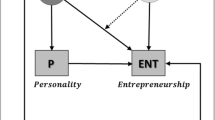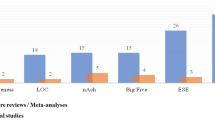Abstract
The tendency to be an entrepreneur may be influenced by genetic variation. Sensation seeking is more common among entrepreneurs than among the general population. Twin studies show that the tendency to be an entrepreneur is heritable and that common genes influence both sensation seeking and entrepreneurial tendency (Nicolaou et al. Manag Sci 54:167–179, 2008a; Strateg Entrep J 2:7–21, 2008b). Since dopamine receptor genes have been associated with novelty seeking/sensation seeking (Benjamin et al. Nat Genet 12:81–84, 1996; Ebstein et al. Nat Genet 12:78–80, 1996; Noblett and Coccaro Curr Psychiatry Rep 7:73–80, 2005), and attention deficit hyperactivity disorder (ADHD) has been reported to occur at greater rates among entrepreneurs, we examined the association between five dopamine receptor genes and four ADHD-associated genes, with the tendency to be an entrepreneur in a sample of 1,335 individuals from the UK. We found a single nucleotide polymorphism (rs1486011) of the DRD3 gene on chromosome 3 to be significantly associated with the tendency to be an entrepreneur. This result is the first evidence of the association of a specific gene with entrepreneurship. Further studies are needed to replicate this association.
Similar content being viewed by others
References
Andrew, T., Hart, D. J., Sneider, H., de Lange, M., Spector, T. D., & MacGregor, A. J. (2001). Are twins and singletons comparable? A study of disease-related and lifestyle and lifestyle characteristics in adult women. Twin Research, 4, 464–477.
Benjamin, J., Li, L., Patterson, C., Greenburg, B. D., Murphy, D. L., & Hamer, D. H. (1996). Population and familial association between the D4 dopamine receptor gene and measures of novelty seeking. Nature Genetics, 12, 81–84.
Cloninger, C. R., Adolfson, R., & Svrakic, N. M. (1996). Mapping genes for human personality. Nature Genetics, 13, 3–4.
Delmar, F., & Davidsson, P. (2000). Where do they come from? Prevalence and characteristics of nascent entrepreneurs. Entrepreneurship and Regional Development, 12, 1–23.
Ebstein, R. P., Novick, O., Umansky, R., Priel, B., Osher, Y., & Blaine, D. (1996). Dopamine D4 receptor (D4DR) exon III polymorphism associated with the human personality trait novelty-seeking. Nature Genetics, 12, 78–80.
Faraone, S. V., & Mick, E. (2010). Molecular genetics of attention deficit hyperactivity disorder. Psychiatric Clinics of North America, 33, 159–180.
Kihlstrom, R., & Laffont, J. J. (1979). A general equilibrium entrepreneurship theory of the firm based on risk aversion. Journal of Political Economy, 87, 719–748.
Lee, J. Y., Lee, E. K., Park, S. S., Lim, J. Y., Kim, H. J., Kim, J. S., et al. (2009). Association of DRD3 and GRIN2B with impulse control and related behaviors in Parkinson’s disease. The Movement Disorder, 15(24), 1803–1810.
Li, J., & Ji, L. (2005). Adjusting multiple testing in multi locus analyses using the eigenvalues of a correlation matrix. Heredity, 95, 221–227.
Light, K. J., Joyce, P. R., Luty, S. E., Mulder, R. T., Frampton, C. M., et al. (2006). Preliminary evidence for an association between a dopamine D3 receptor gene variant and obsessive-compulsive personality disorder in patients with major depression. American Journal of Medical Genetics Part B Neuropsychiatric Genetics, 141B(4), 409–413.
Lobo, D. S., Souza, R. P., Tong, R. P., Casey, D. M., Hodgins, D. C., et al. (2010). Association of functional variants in the dopamine D2-like receptors with risk for gambling behaviour in healthy Caucasian subjects. Biological Psychology, 85(1):33–37.
Mannuzza, S., Klein, R. G., Bessler, A., Malloy, P., & LaPadula, M. (1993). Adult outcome of hyperactive boys. Educational achievement, occupational rank, and psychiatric status. Archives of General Psychiatry, 50, 565–576.
Neve, K. (2009). The dopamine receptors (2nd ed.). Totowa, NJ: Humana Press.
Nicolaou, N., Shane, S., Cherkas, L., Hunkin, J., & Spector, T. (2008a). Is the tendency to engage in entrepreneurship genetic? Management Science, 54, 167–179.
Nicolaou, N., Shane, S., Cherkas, L., & Spector, T. (2008b). The influence of sensation seeking in the heritability of entrepreneurship. Strategic Entrepreneurship Journal, 2, 7–21.
Noblett, K. L., & Coccaro, E. F. (2005). Molecular genetics of personality. Current Psychiatry Reports, 7, 73–80.
Nyholt, D. (2004). A simple correction for multiple testing for single-nucleotide polymorphisms in linkage disequilibrium with each other. American Journal of Human Genetics, 74, 765–769.
Oades, R. D., Lasky-Su, J., Christiansen, H., Faraone, S. V., Sonuga-Barke, E. J., et al. (2008). The influence of serotonin- and other genes on impulsive behavioral aggression and cognitive impulsivity in children with attention-deficit/hyperactivity disorder (ADHD): Findings from a family-based association test (FBAT) analysis. Behavioral and Brain Functions, 4, 48.
Okuyama, Y., Ishiguro, H., Nankai, M., Shibuya, H., Watanabe, A., & Arinami, T. (2000). Identification of a polymorphism in the promoter region of DRD4 associated with the human novelty seeking personality trait. Molecular Psychiatry, 5, 64–69.
Purcell, S., Neale, B., Todd-Brown, K., Thomas, L., Ferreira, M. A. R., et al. (2007). PLINK: A toolset for whole-genome association and population-based linkage analysis. American Journal of Human Genetics, 81, 559–575.
Rosenbloom, T. (2003). Risk evaluation and risky behavior of high and low sensation seekers. Social Behavior and Personality, 31, 375–386.
Shane, S. (2003). A general theory of entrepreneurship: The individual-opportunity nexus. Aldershot, UK: Edward Elgar Publishing.
Spector, T. D., & Williams, F. M. (2006). The UK Adult Twin Registry (TwinsUK). Twin Research and Human Genetics, 9(6), 899–906.
Staner, L., Hilger, C., Hentges, F., et al. (1998). Association between novelty-seeking and the dopamine D3 receptor gene in bipolar patients: A preliminary report. American Journal of Medical Genetics, 81, 192–194.
Thornton, T., & McPeek, M. S. (2007). Case-control association testing with related individuals: A more powerful quasi-likelihood score test. American Journal of Human Genetics, 81, 321–337.
Van Tol, H., Bunzow, J., Guan, H., Sunahara, R., Seeman, P., Niznik, H., et al. (1991). Cloning of the gene for a human dopamine D4 receptor with high affinity for the antipsychotic clozapine. Nature, 350, 610–614.
Zuckerman, M. (1979). Sensation seeking: Beyond the optimal level of arousal. Hillsdale, NJ: Lawrence Erlbaum.
Zuckerman, M. (1994). Behavioral expressions and biosocial bases of sensation seeking. Cambridge: Cambridge University Press.
Zuckerman, M. (2004). The shaping of personality: Genes, environments, and chance encounters. Journal of Personality Assessment, 82, 11–22.
Zuckerman, M., Eysenck, S., & Eysenck, H. J. (1978). Sensation seeking in England and America: Cross-cultural, age, and sex comparisons. Journal of Consulting and Clinical Psychology, 46, 139–149.
Acknowledgments
We would like to thank the twins that participated in our study. We are most grateful for funding from Philip Zepter grant no. ucy 31028.
Author information
Authors and Affiliations
Corresponding author
Additional information
Nicos Nicolaou and Scott Shane contributed equally to this work.
Rights and permissions
About this article
Cite this article
Nicolaou, N., Shane, S., Adi, G. et al. A polymorphism associated with entrepreneurship: evidence from dopamine receptor candidate genes. Small Bus Econ 36, 151–155 (2011). https://doi.org/10.1007/s11187-010-9308-1
Accepted:
Published:
Issue Date:
DOI: https://doi.org/10.1007/s11187-010-9308-1




